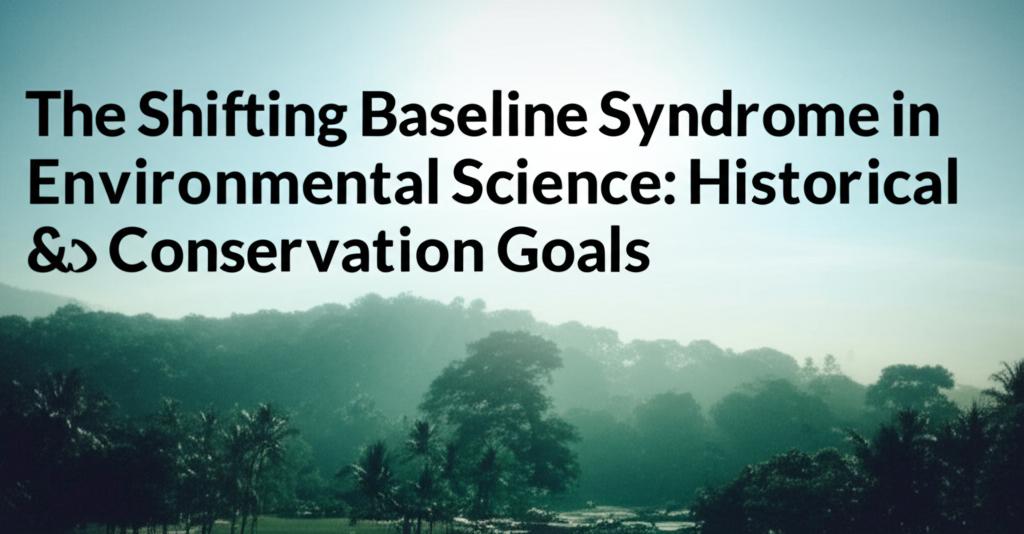Imagine a world where vibrant coral reefs, teeming with a kaleidoscope of fish, were the norm. Picture skies darkened by immense flocks of passenger pigeons or rivers so thick with salmon you could practically walk across their backs. For many today, these scenes are confined to history books or nature documentaries. This slow, often unnoticed, creep of environmental degradation, where each new generation accepts a more depleted version of nature as "normal," is the crux of Shifting Baseline Syndrome (SBS). It's a phenomenon with profound implications for how we perceive our planet's health and, crucially, how we define our conservation goals.
Coined by fisheries scientist Daniel Pauly in 1995, SBS describes how our collective memory of environmental conditions erodes over time. Each generation takes the state of the environment they grew up in as their baseline, their reference point for what is natural and healthy. As ecosystems degrade incrementally – a little less birdsong each spring, fewer insects on the windshield, smaller fish in the catch – these new, diminished states become the accepted "normal" for the next cohort. This "environmental generational amnesia" means we often fail to grasp the true extent of long-term ecological change.
The insidious nature of Shifting Baseline Syndrome lies in its subtlety. It's not a sudden catastrophe that grabs headlines, but a quiet erosion of biodiversity and ecosystem health. This makes it a fundamental obstacle to addressing global environmental issues. If we don't recognize what we've lost, or what a truly thriving ecosystem looks like, our motivation to enact meaningful conservation or restoration efforts is blunted. We might set conservation targets based on already degraded states, aiming for a "good" that is a pale shadow of the historical reality. This can lead to "conservation complacency," where we become satisfied with maintaining an already diminished environment.
Historical ecology plays a vital role in combating SBS. By piecing together past ecological conditions using diverse sources – from old photographs and fishermen's logs to sediment cores and genetic analysis – scientists can reconstruct more accurate historical baselines. This isn't about trying to turn back the clock to a specific historical point, as ecosystems are naturally dynamic. Instead, it's about understanding the range of natural variability, the magnitude of past biodiversity, and the functioning of ecosystems before significant human alteration. This knowledge is critical for setting ambitious and ecologically relevant conservation goals.
For example, rewilding projects, which aim to restore natural processes and reintroduce keystone species, often highlight the impact of SBS. Species once thought to prefer certain habitats are sometimes found to thrive in conditions we’ve forgotten were part of their natural range, simply because they were pushed to the brink and survived only in those limited areas. Restoring historical herbivore grazing patterns, for instance, can lead to unexpected increases in biodiversity, revealing a richer ecological tapestry than our shifted baselines might have led us to expect.
The challenge, then, is to bridge the gap between scientific understanding of historical ecosystems and public perception. If the public is unaware of the extent of past environmental change, support for bold conservation initiatives may be lacking. Education and outreach are key. Sharing stories and data about past ecological states can help recalibrate our collective baseline, fostering a deeper appreciation for what has been lost and what could potentially be regained.
Interestingly, SBS isn't always about degradation. In some instances, successful conservation efforts can lead to a "lifting baseline," where a recovering species is perceived as overabundant or even a nuisance by a public unfamiliar with its historical population levels. This underscores the importance of historical context in all conservation discussions.
Overcoming Shifting Baseline Syndrome requires a multi-pronged approach. Firstly, continued research into historical ecology is essential to establish more accurate benchmarks. Secondly, this information needs to be effectively communicated to the public and policymakers to raise awareness. Encouraging intergenerational communication, where older generations share their memories of past environments, can also play a part. Finally, fostering direct experiences with nature, particularly for younger generations, can help build a stronger connection to and appreciation for the natural world, potentially creating more resilient baselines for the future.
Ultimately, recognizing and addressing Shifting Baseline Syndrome is crucial for the future of conservation. By understanding the past, we can more clearly see the present and forge more ambitious and meaningful goals for the future of our planet’s rich, and often diminished, ecosystems. It's about ensuring that "normal" doesn't continue its silent, downward drift, but instead is thoughtfully redefined based on a deeper ecological understanding and a rekindled sense of wonder for the wild world.

